Giantreed Giant Reed
(Phragmites australis australis)

Description
Arundo donax is a tall perennial cane. It is one of several so-called reed species. It has several common names including giant cane, elephant grass, carrizo, arundo, Spanish cane, Colorado river reed, wild cane, and giant reed. Arundo donax grows in damp soils, either fresh or moderately saline, and is native to the Greater Middle East. It has been widely planted and naturalised in the mild temperate, subtropical and tropical regions of both hemispheres, especially in the Mediterranean, California, the western Pacific and the Caribbean. It forms dense stands on disturbed sites, sand dunes, in wetlands and riparian habitats. Arundo donax flowers in late summer, bearing upright, feathery plumes 40 to 60 centimetres (16 to 24 in) long, that are usually seedless or with seeds that are rarely fertile. Instead, it mostly reproduces vegetatively by tough, fibrous underground rhizomes that form knotty, spreading mats which penetrate deep into the soil, up to 1 metre (3.3 ft) deep (Alden et al., 1998; Mackenzie, 2004). Stem and rhizome pieces less than 5 centimetres (2.0 in) long and containing a single node could sprout readily under a variety of conditions (Boose and Holt, 1999). This vegetative propagation appears well adapted to floods, which may break up individual A. donaxclumps, spreading the pieces, which may sprout and colonise downstream (Mackenzie 2004). Arundo donax is a tall, perennial C3 grass in the subfamily Arundinoideae. Stems produced during the first growing season are unbranched and photosynthetic. In the Mediterranean, where a temperate climate is characterized by warm and dry summer and mild winter, new shoots of giant reed emerge around March, growing rapidly in June and July and producing stems and leaves. From late July the lower leaves start to dry, depending on seasonal temperature patterns. Drying accelerates during autumn when anthesis occurs from the beginning of October to the end of November. In this phenological stage moisture content falls significantly. In the low temperatures of winter giant reed stops its growth; regrowth occurs in springtime. Giant reed behaves as an annual in Central Europe where soil temperatures are low, due to poor freeze tolerance of the rhizomes.
Taxonomic tree:







